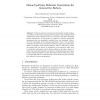Free Online Productivity Tools
i2Speak
i2Symbol
i2OCR
iTex2Img
iWeb2Print
iWeb2Shot
i2Type
iPdf2Split
iPdf2Merge
i2Bopomofo
i2Arabic
i2Style
i2Image
i2PDF
iLatex2Rtf
Sci2ools
96
Voted
IEAAIE
2010
Springer
2010
Springer
Down-Up-Down Behavior Generation for Interactive Robots
Behavior generation in humans and animals usually employs a combination of bottom-up and top-down patterns. Most available robotic architectures utilize either bottom-up or top-down activation including hybrid architectures. In this paper, we propose a behavior generation mechanism that can seamlessly combine these two strategies. One of the main advantages of the proposed approach is that it can naturally combine both bottom-up and top-down behavior generation mechanisms which can produce more natural behavior. This is achieved by utilizing results from the theory of simulation in neuroscience which tries to model the mechanism used in human infants to develop a theory of mind. The proposed approach was tested in modeling spontaneous gaze control during natural face to face interactions and provided more natural, human-like behavior compared with a state-of-the-art gaze controller that utilized a bottom-up approach.
Artificial Intelligence | Behavior Generation | Behavior Generation Mechanisms | IEAAIE 2010 | Top-down |
Related Content
| Added | 13 Feb 2011 |
| Updated | 13 Feb 2011 |
| Type | Journal |
| Year | 2010 |
| Where | IEAAIE |
| Authors | Yasser F. O. Mohammad, Toyoaki Nishida |
Comments (0)

